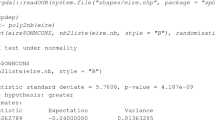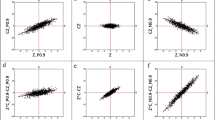Abstract
Spatial autocorrelation measures the degree to which a spatial phenomenon is correlated with itself in space. As such, it can be used as an indicator of the fundamental topological structure of the spatial relationship among geographic entities displayed on a map. Statistics of spatial autocorrelation are especially useful for characterizing the spatial pattern in the distribution of any phenomenon in question. This paper addresses three important issues pertaining to the evaluation of spatial autocorrelation: measurement of the study variable, definition of geographic units, and specification of spatial weighting functions. Theoretically, spatial autocorrelation is most adequately evaluated when the study variable is measured in either an interval or a ratio scale and geographic units are better delineated by polygons of homogeneous surfaces based on variables that are significant to the distribution of the study phenomenon. In evaluating spatial autocorrelation, weighting functions such as area, boundary length, distance, and their combinations must be examined carefully and specified whenever necessary.
Preview
Unable to display preview. Download preview PDF.
Similar content being viewed by others
References
Y.H. Chou: Map resolution and spatial autocorrelation. Geographical Analysis, 23, 228–246 (1991).
Y.H. Chou: Management of wildfires with a geographical information system. International Journal of Geographic Information Systems, 6, 123–140 (1992).
Y.H. Chou: Spatial autocorrelation and weighting functions in the distribution of wildland fires. International journal of Wildland Fire, 2, 169–176 (1992).
Y.H. Chou, R. A. Minnich, and R.A. Chase: Mapping probability of fire occurrence in the San Jacinto Mountains, California. Environmental Management, 17, 129–140 (1993).
AD. Cliff and J.K. Ord: Spatial Processes: Models and Applications, London: Pion (1981).
M.F. Dacey: A review of measures of contiguity for two and K-color maps, in B.J.L. Barry and D.F. Marble (editors), Spatial Analyses: A Reader in Statistical Geography, Englewood Cliffs, New Jersey: Prentice-Hall (1965).
R.C. Geary: The contiguity ratio and statistical mapping, The Incorporated Statistician, 5, 115–145 (1954).
A. Getis: A spatial association model approach to the identification of spatial dependence, Geographical Analysis, 16, 17–24 (1989).
A. Getis: Spatial interaction and spatial autocorrelation: a cross-product approach, Environment and Planning A, 23, 1269–1277 (1991).
A. Getis and J.K. Ord: The analysis of spatial association by use of distance statistics, Geographical Analysis, 24, 189–206 (1992).
P. Haggett: Hybridizing alternative models of an epidemic diffusion process, Economic Geography, 52, 136–146 (1976).
P. de Jong, C. Sprenger, and F. van Veen: On extreme values of Moran's / and Geary's C, Geographical Analysis, 16, 17–24 (1984).
P.A.P. Moran: The interpretation of statistical maps, Journal of the Royal Statistical Society, Series B, 37, 243–51 (1948).
P.A.P. Moran: Notes on continuous stochastic phenomena, Biometrika, 37, 17–23 (1950)
J. O'Loughlin: Spatial models of international conflicts: extending current theories of war behavior, Annals of the Association of American Geographers, 76, 63–80(1986).
W.R. Tobler: A computer movie simulating urban growth in the Detroit region, Economic Geography, 46, 234–240 (1970).
Author information
Authors and Affiliations
Editor information
Rights and permissions
Copyright information
© 1993 Springer-Verlag Berlin Heidelberg
About this paper
Cite this paper
Chou, YH. (1993). Critical issues in the evaluation of spatial autocorrelation. In: Frank, A.U., Campari, I. (eds) Spatial Information Theory A Theoretical Basis for GIS. COSIT 1993. Lecture Notes in Computer Science, vol 716. Springer, Berlin, Heidelberg. https://doi.org/10.1007/3-540-57207-4_28
Download citation
DOI: https://doi.org/10.1007/3-540-57207-4_28
Published:
Publisher Name: Springer, Berlin, Heidelberg
Print ISBN: 978-3-540-57207-7
Online ISBN: 978-3-540-47966-6
eBook Packages: Springer Book Archive




